Coming Soon to a Neighborhood Near You?
Off-Campus Recruiting by Public Research Universities
Karina Salazar
University of Arizona
Ozan Jaquette
University of California, Los Angeles
Crystal Han
University of California, Los Angeles


ozanj.github.io/naed_presentation
Acknowledgments
This research was made possible by funding from the following sources:
- National Academy of Education/Spencer Foundation (Postdoctoral Fellowship)
- American Educational Research Association (Dissertation Grant)
- UCLA Office of Equity, Diversity, and Inclusion (Faculty Career Development Award)
- Joyce Foundation (Research Grant)
Motivation
The problem with policy discourse about college access
The 2014 White House "Access Summit"
- The White House (2014a) review of causes of unequal college access
- Highlights "achievement gap", "under-matching"
- Commitments to Action on College Opportunity (The White House, 2014b)
- Universities pledge "action plans" (e.g., holistic admission, need-based aid, "outreach")
Problem with policy discourse
- Place responsibility on students, K-12 schools; assume universities are passive or progressive
Alternative explanation for access inequality
- University enrollment priorities biased against poor students and/or communities of color
Research focus (this paper)
- We argue recruiting behavior is an indicator of enrollment preferences
- Research question: What are the similarities and differences in off-campus recruiting patterns across public research universities?
Background
The enrollment management industry
The enrollment funnel
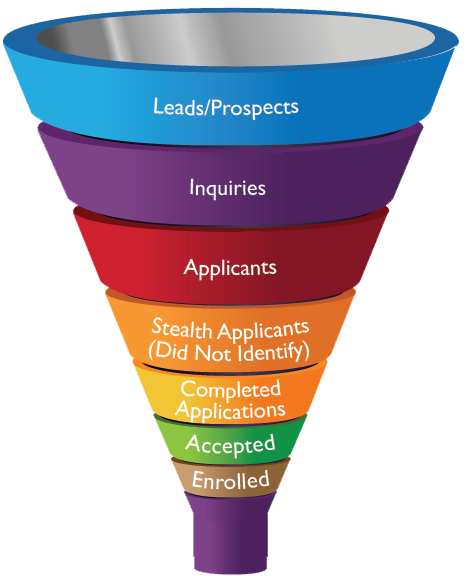
Interventions along the funnel
- Identify prospects
- Purchase "student lists"
- Recruit prospects remotely
- Email, mail, text, etc.
- Recruit prospects in-person
- Off-campus recruiting visits (e.g., high school visits, fairs)
- Campus visits
- Other "outreach"
- Solicit inquiries, stealth applicants
- Social media, advertising
- Convert admits to enrollees
- Financial aid leveraging
Literature review
Scholarship on the enrollment funnel
Most research analyzes admissions (e.g., Killgore, 2009) or financial aid (e.g., McPherson, Schapiro, 1998)
- Final stages of enrollment funnel
Scholarship on recruiting is sparse
- Audits of university response to inquiries (e.g., Hanson, 2017; Thornhill, forthcoming)
- Off-campus recruiting visits
- From the college perspective (Stevens, 2007)
- Important for relationships with prospects, counselors at "feeder" schools
- From the perspective of high school students (Holland, 2019)
- Which universities visit affects student decisions; especially first-gen, students of color
- From the college perspective (Stevens, 2007)
Research gap
- We don't know which universities visit which schools and communities
- If poor students, communities of color are not being recruited, then "under-matching" may be due to under-recruiting rather than lack of guidance
Theoretical motivation
Enrollment priorities and recruiting behavior
Organizational theory
- Contingency theory (Thompson, 1967)
- Technical level vs. managerial level
- "New" institutional theory (Meyer and Rowan, 1977)
- Publicly adopt goals demanded by environment
- Technical level cannot pursue all goals
- Substantively adopt some goals (technical level)
- Symbolically adopt others (policies, rhetoric)
Application to enrollment management (EM)
- "Iron triangle" of EM highlights three broad enrollment goals: access, academic profile, revenue
- Resources scarce; depending on priorities, some goals receive more resources than others
- Enrollment priorities cannot be discerned by policies, rhetoric
- Recruiting is allocation of resources from technical level
- Knowing which populations targeted by recruiting interventions indicate enrollment priorities
Research overview
The broader off-campus recruiting research project
Data collection
- Method
- Web-scrape admissions websites
- Criteria to be included in data collection
- Post visits on admissions websites
- Organizational type
- Data collection sample
- 54 public research universities
- 49 private research universities
- 42 selective private liberal arts
- Data collection period
- 1/1/2017 to 12/31/2017
- Ongoing data collection with larger sample
Sample data
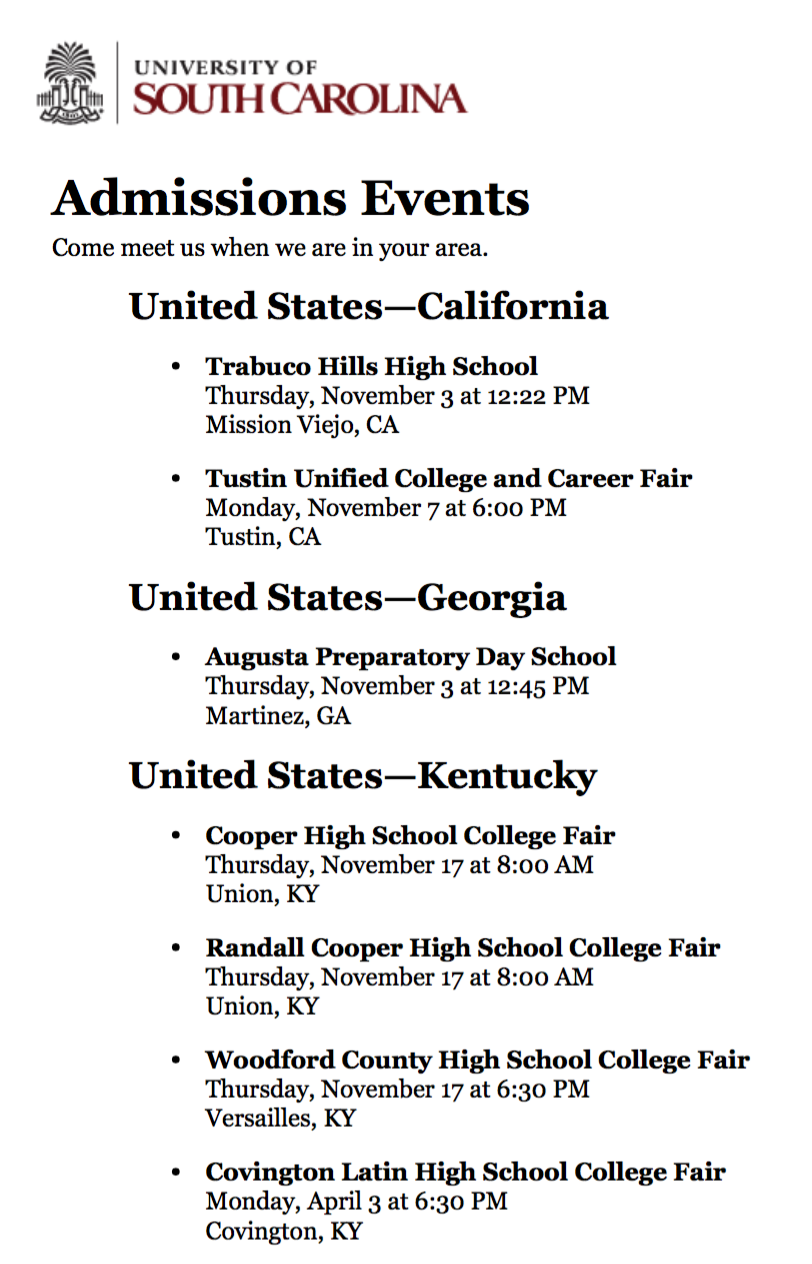
Research overview
Focus of this research paper
Research question: what are the similarities and differences in off-campus recruiting patterns across public research universities?
- Quantitative multiple case study of 15 public research universities
Why this research question:
- First paper from the larger study
- Explore behavior inductively, rather than test specific hypotheses
- Subsequent papers more focused, thematic (e.g., racial red-lining, international recruiting)
Why focus on public research universities:
- Historic mission of social mobility for state residents
- Decline in state funding, growth in nonresident enrollment (Jaquette and Curs, 2015)
- What are they doing to get all these nonresidents? More effort recruiting nonresidents than residents?
Research methods
Defining events
"Off-campus recruiting events" defined as off-campus events hosted by paid staff/consultants focused on soliciting applications
- Event type
- Include: college fairs, high school visits, community college visits, counselor events
- Exclude: admitted or committed student events, interviews
- Event host
- Include: paid admissions staff or consultants (e.g. regional recruiters)
- Exclude: alumni, student volunteers
- Event location
- Any off-campus location
- e.g., high school, community college, hotel, convention center, cafe, etc.
Research methods
Data collection, data processing, data quality
Data collection
- University website checked four times per year by two staff for URLs with recruiting events
- Web-scraping scripts run once per week
Data processing
- "Parsing": transform HTML text into tabular data
- "Geocoding": use Google Maps API to obtain detailed location data based on limited data
- Merge recruiting data to secondary data (e.g., schools, communities)
Data quality (are these data any good?)
- Concern 1: are scraped events properly classified and merged to secondary data?
- Solution: manually check each scraped event
- 8 of 15 universities checked thus far
- Solution: manually check each scraped event
- Concern 2: are all events posted on admissions website?
- Solution: issue public records requests for all off-campus recruiting events
- Received data from 7 of 15 universities; not yet incorporated
- Solution: issue public records requests for all off-campus recruiting events
Research methods
Secondary data
Secondary data Sources:
- NCES Common Core of Data (public high schools)
- NCES Private School University Survey (private high schools)
- U.S. Census American Community Survey (community characteristics)
- IPEDS (community colleges)
- EdFacts Initiative (public high school academic achievement)
- Equality of Opportunity Project (university income distributions)
Research methods
Research design for analyses
Quantitative multiple case study design
- "Quantitative case study" uses quantitative data as sole source of evidence (Korzilius, 2010)
- "Within-case" analyses of recruiting patterns
- Situate within local context; national overview; "deep dive" of in-state and out-of-state patterns
- Simple descriptive statistics (e.g., counts), static visualizations, interactive maps
- "Cross-case" analyses
- Descriptive statistics and qualitative coding methods
Comparison to alternative research designs
- Large-N, random sample design
- Not possible because recruiting data unavailable for random sample
- Not desirable for present research because large-N designs pool results across cases
- Qualitative case study (usually collect data from multiple sources)
- Our design is narrowly focused, systematic analysis of particular phenomena
- Unlike Stevens (2007), we do not develop a holistic understanding of recruiting behavior
Research methods
Analysis sample
Analysis sample consists of 15 public research universities
- Chosen from larger data collection sample (N=54) based on "completeness" of recruiting event data
- Subsequent drafts may reduce sample size based on principles of purposeful sampling (Patton, 2002)
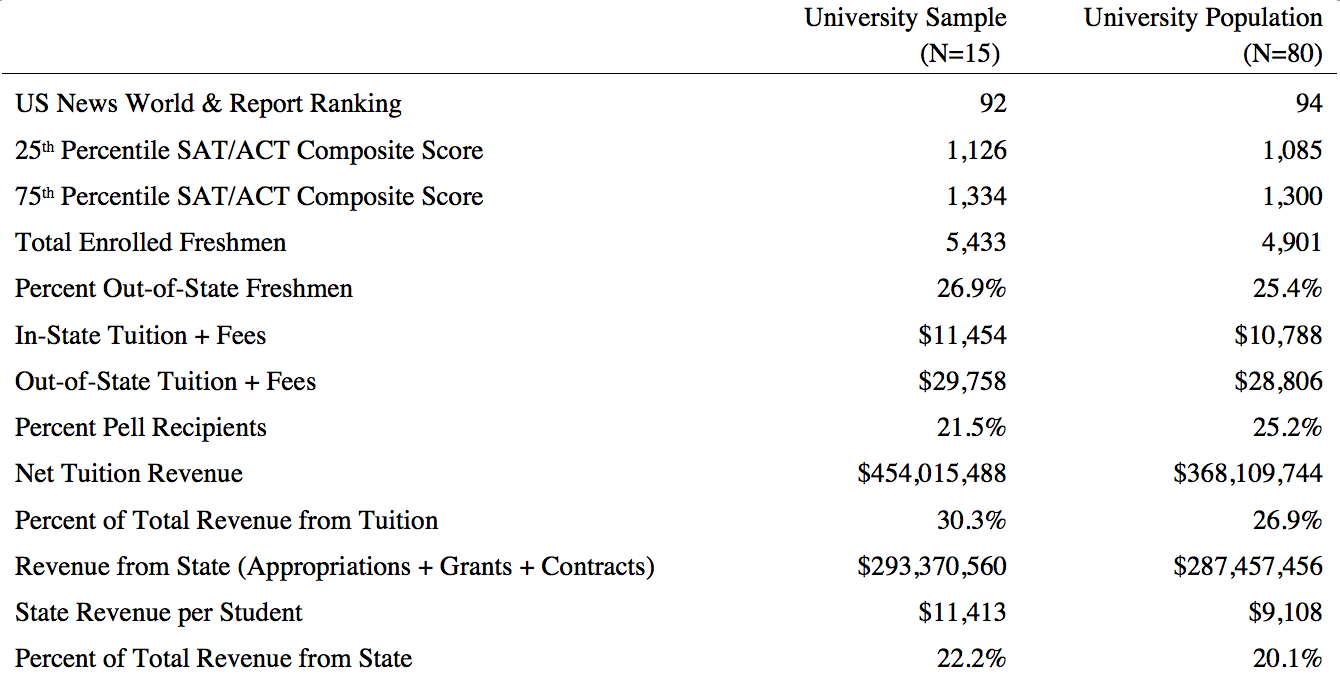
Deep-Dive Results
Click on a university to take a closer look at the results
N refers to total number of off-campus recruiting visits
- North Carolina State University (N=649)
- Rutgers University-New Brunswick (N=1,143)
- Stony Brook University (N=730)
- University of Alabama (N=4,261)
- University of Arkansas (N=1,001)
- University of California-Berkeley (N=879)
- University of California-Irvine (N=540)
- University of Cincinnati (N=681)
- University of Colorado-Boulder (N=1,445)
- University of Georgia (N=834)
- University of Kansas (N=1,023)
- University of Massachusetts-Amherst (N=908)
- University of Nebraska-Lincoln (N=1,404)
- University of Pittsburgh (N=1,232)
- University of South Carolina-Columbia (N=1,472)
National Overview
In-State Results
State Map
In-State Results
State Figures
In-State Results
Metro Area Map
In-State Results
Metro Area Figures
Out-of-State Results
Top Visited Metro Areas
Out-of-State Results
Out-of-State Results
Metro Area Map
Out-of-State Results
Metro Area Figures
Out-of-State Results
Metro Area Map
Out-of-State Results
Metro Area Figures
Cross-university comparisons
Map of Visits
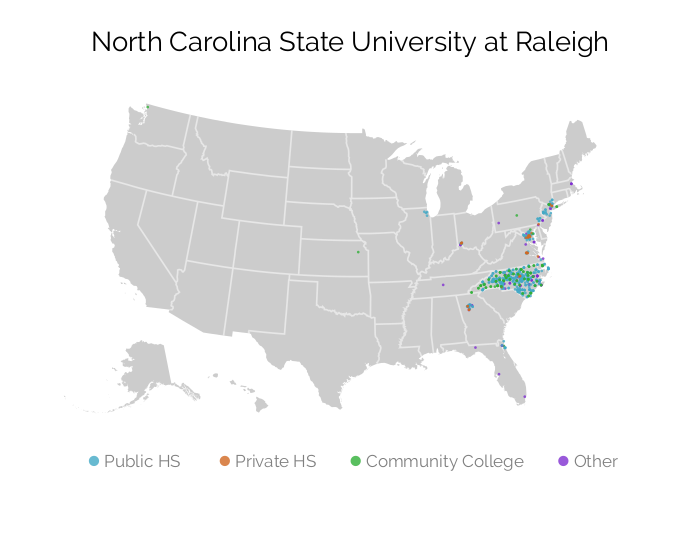














Cross-university comparisons
Number of events by event type
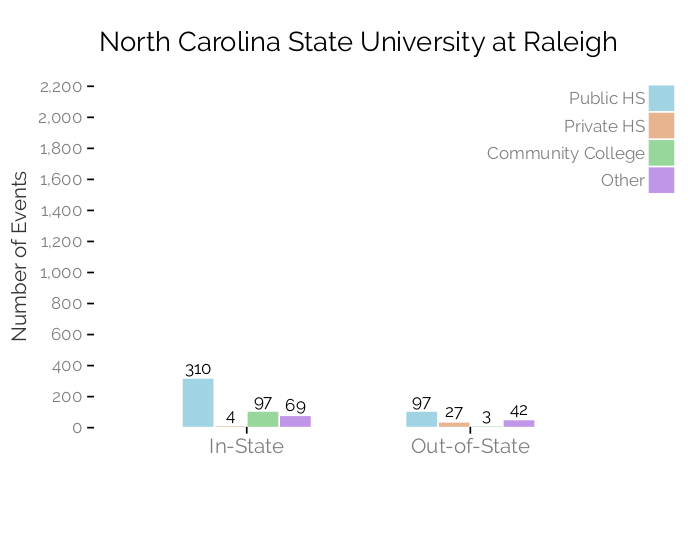














Summary
Summary of results and next steps for this paper
Summary of results
- Majority of universities in our sample hosted twice as many out-of-state events as in-state events
- Out-of-state events focus on affluent public schools and private schools
- Several universities focus more on in-state recruiting (e.g., U. Nebraska, North Carolina State)
- In-state visits tend to show little evidence of income or racial bias
- Some universities (e.g., Rutgers) show income/racial bias even in in-state visits
- Must investigate whether bias persists after controlling for academic achievement, etc.
Next steps
- Complete data quality checks (e.g., incorporate data from public records requests)
- Conduct "deep dive" for all universities
- Compare results across universities
- Quantitative descriptive analyses; qualitative coding
- Develop broad categories of recruiting "types" and categorize universities
Future research
Using "data science" and public records requests to study recruiting
Off-campus recruiting project
- Expand data collection (e.g., regional public universities); publicly release all data
- Develop manuscripts with more narrow focus (e.g., nexus between state/local politics and visits)
Student list project (collected pilot data)
- Which student characteristics do universities prioritize when purchasing prospect lists from College Board/ACT?
- Data collection: Public records requests
Experimental audits of university responses to "inquiries" (pre-pilot stage)
- More favorable response to inquiries with certain characteristics (e.g., affluence of zip-code/school, evidence of third-party grant/loan)?
- Data collection: Automate emails; auto-fill "inquiry forms"
Impact goals
- Change national policy discourse on access inequality
- Empower local actors to hold universities accountable for access commitments (example HERE)
- Unless we document enrollment management behavior, we invite symbolic responses
References
[1] A. Hanson. “Do college admissions counselors discriminate? Evidence from a correspondence-based field experiment”. In: Economics of Education Review 60 (2017), pp. 86-96. ISSN: 0272-7757. DOI: https://doi.org/10.1016/j.econedurev.2017.08.004. URL: http://www.sciencedirect.com/science/article/pii/S0272775716304526.
[2] M. M. Holland. Divergent pathways to college: Race, class, and inequality in high schools. New Brunswick, NJ: Rutgers University Press, 2019.
[3] O. Jaquette and B. R. Curs. “Creating the out-of-state university: Do public universities increase nonresident freshman enrollment in response to declining state appropriations?” In: Research in Higher Education 56.6 (2015), pp. 535-565. ISSN: 0361-0365.
[4] L. Killgore. “Merit and Competition in Selective College Admissions”. In: Review of Higher Education 32.4 (2009), pp. 469-488. ISSN: 0162-5748; 1090-7009. URL: <Go to ISI>://WOS:000266737500002.
[5] H. Korzilius. “Quantitative Analysis in Case Study”. In: Encyclopedia of case study research. Ed. by A. J. Mills, G. Durepos and E. Wiebe. Thousand Oaks: SAGE Publications, Inc., 2010, pp. 760-764.
[6] M. S. McPherson and M. O. Schapiro. The student aid game. Princeton, NJ: Princeton University Press, 1998.
[7] J. W. Meyer and B. Rowan. “Institutionalized organizations: formal structure as myth and ceremony”. In: The American Journal of Sociology 83.2 (1977), pp. 340-363.
[8] M. Q. Patton. Qualitative research and evaluation methods. Thousand Oaks, Calif.: Sage, 2002. ISBN: 0761919716 9780761919711.
[9] M. L. Stevens. Creating a class: College admissions and the education of elites. Cambridge, MA: Harvard University Press, 2007, p. 308 p. ISBN: 9780674026735 (alk. paper) 067402673X (alk. paper).
[10] The White House. Commitments to action on college opportunity. Tech. rep. The Executive Office of the President, 2014.
[11] The White House. Increasing college opportunity for low-income students. Tech. rep. The Executive Office of the President, 2014.
[12] J. Thompson. Organizations in action. New York: McGraw Hill, 1967.
[13] T. Thornhill. “We Want Black Students, Just Not You: How White Admissions Counselors Screen Black Prospective Students”. In: Sociology of Race and Ethnicity 0.0 (). DOI: 10.1177/2332649218792579. URL: https://journals.sagepub.com/doi/abs/10.1177/2332649218792579.